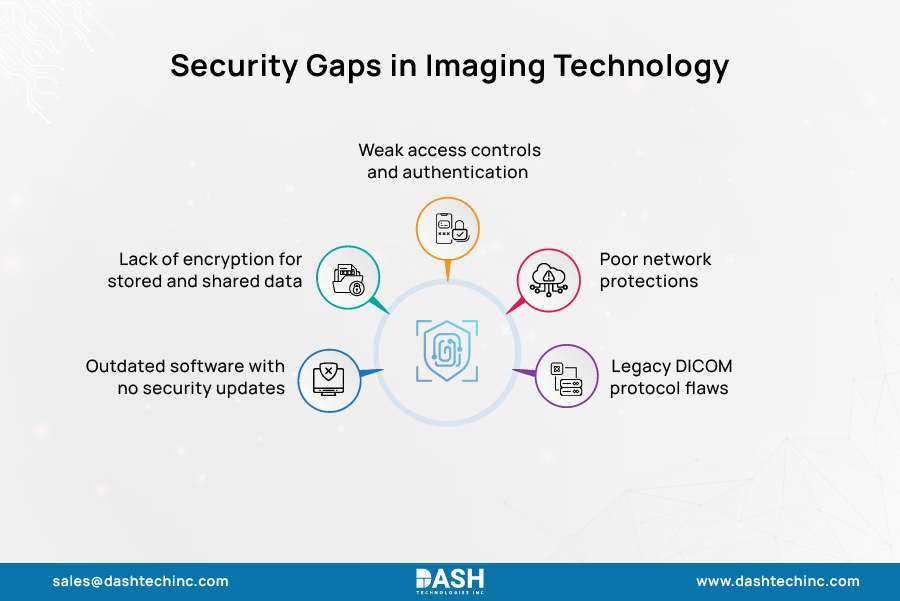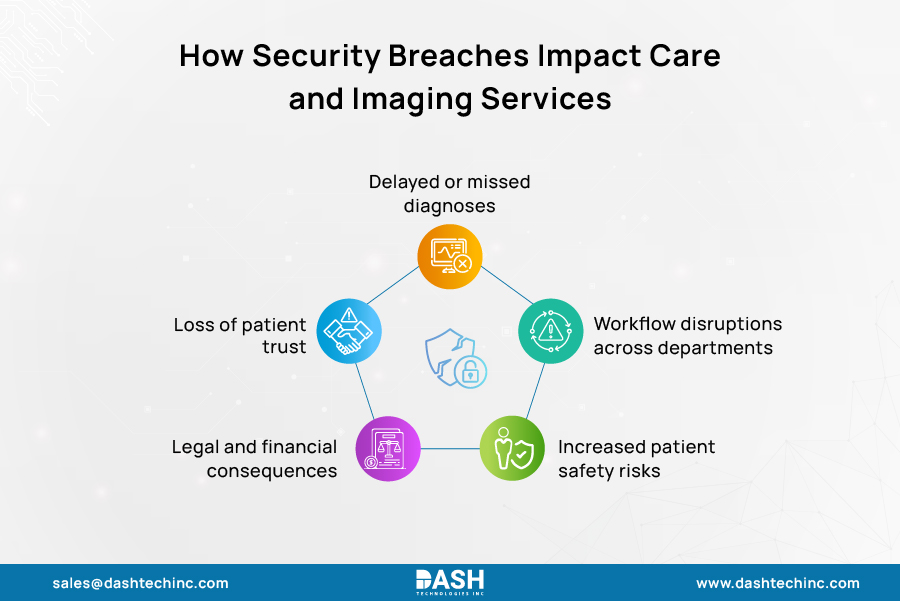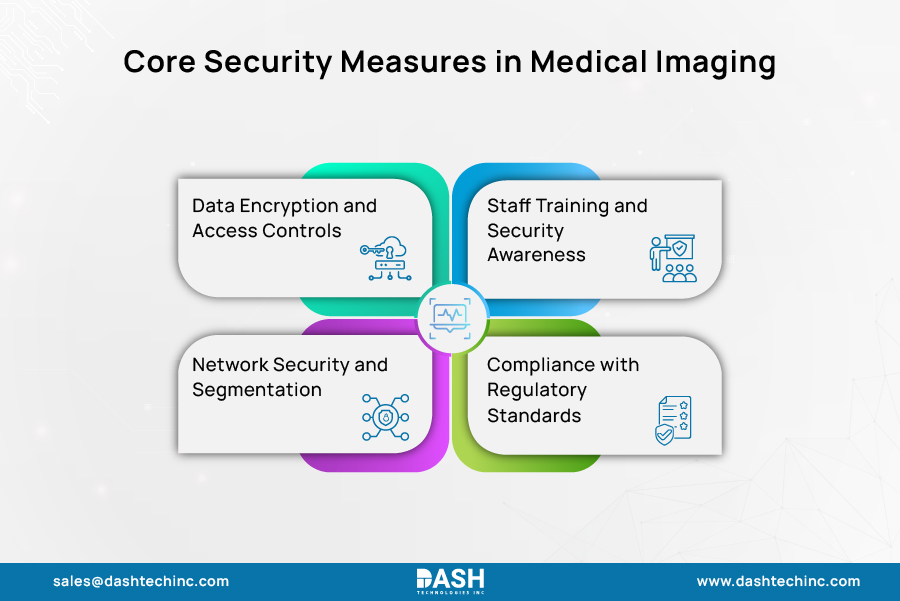Patient Privacy: The Need for Secure Medical Imaging Services
Current patient diagnostics & treatment practices depend fundamentally on medical imaging services. Medical images from X-rays to MRIs help doctors diagnose patients accurately while allowing them to create treatment plans and track patient recovery. The digital transformation of healthcare has led to an exponential increase in the availability of medical images, which delivers significant advantages in terms of speed and efficiency alongside better collaborative opportunities.
The shift to digital healthcare systems creates major security risks. Medical images contain Protected Health Information (PHI), which makes them attractive targets for security breaches due to their sensitive nature. Healthcare providers & technology decision-makers must now understand & implement essential security measures for these critical assets because it has become a fundamental necessity.
Understanding Medical Imaging Systems and PACS
Medical imaging services rely on Picture Archiving and Communication Systems (PACS) as their core technological foundation. These systems offer a single location for digital medical image storage, allowing healthcare workers to retrieve and send patient scans from workstations and mobile devices.
PACS systems replace physical file storage & manual film transport with digital solutions, greatly enhancing healthcare operational efficiency. These systems connect to other healthcare technologies using the DICOM standard, which provides the capability to interface with both Radiology Information Systems & Hospital Information Systems.
Discover How AI is Changing Medical Imaging
Download our eBook for expert insights on AI integration, workflow optimization, and real-world applications that advance diagnostic precision and efficiency.
Access Your Free eBookCloud solutions have further revolutionized medical imaging by offering:
- Store data economically because hardware purchase and maintenance requirements are eliminated
- Scalability that accommodates growing practices without additional infrastructure investments
- Enhanced accessibility that allows physicians to view patient data beyond hospital settings
- Improved interoperability between different healthcare systems and providers
These cloud-based PACS solutions enable healthcare providers to store and share digital images and clinical evaluations securely, removing the manual tasks associated with physical records management.
Security Challenges in Medical Imaging
Medical imaging services’ security issues can lead to patient data breaches and healthcare system disruptions. Protective measures become effective only after a thorough understanding of system vulnerabilities.
Common Vulnerabilities in Medical Imaging Systems

A variety of factors render medical imaging systems susceptible to cyber threats:
- Outdated Software: Medical imaging devices often operate using outdated operating systems, which no longer receive new security updates, leading to exploitable system weaknesses.
- Lack of Encryption: Patient data remains unprotected when healthcare systems fail to encrypt it during storage and transmission.
- Inadequate Access Controls: Poor security measures for user authentication and authorization enable unauthorized individuals to access medical imaging systems.
- Poor Network Security: Attackers can gain access through imaging devices when they connect to larger networks without adequate security protections.
- Legacy DICOM Protocol Issues: According to research findings the outdated DICOM protocol has left around 60 million records exposed throughout the previous decades because of inadequate security measures.
These vulnerabilities produce serious consequences for both financial and operational aspects of affected systems. Radiology & healthcare partners face major financial burdens from cyberattacks through expenses for breach notifications and identity theft services along with legal fees and other possible regulatory penalties.
Impact on Patient Care

Security breaches in healthcare medical imaging services go far beyond financial loss- they have a direct & sometimes severe impact on patient care. When cyberattacks disrupt medical imaging systems, the consequences can be immediate and far-reaching for both patients and providers.
Delays in Critical Diagnostics: Ransomware or other cyber threats can stop access to important or essential healthcare medical imaging services, which in turn delay diagnoses and treatment, which in emergencies can be life-threatening.
Widespread Disruption: According to a survey, 74% of hospitals experienced direct patient care disruptions after cyberattacks; while 40% of them reported patients faced care access issues due to imaging data processing delays.
Increased Patient Risk: Downed imaging systems force patients to be sent elsewhere, fragmenting their care and creating possible gaps in their medical history. According to some documented cases, major ransomware attacks on healthcare networks can result in a 20–35% increase in in-hospital mortality rates.
Loss of Patient Trust: Patients expect healthcare providers to protect their sensitive information and imaging results. When a breach occurs, it destroys patient trust, damages the provider’s reputation, and opens possibilities for regulatory penalties and legal challenges.
Tampering and Data Manipulation: Malicious actors can alter or damage imaging data, resulting in erroneous or overlooked medical diagnoses. Adversarial attacks targeting AI imaging systems manage to deceive both the software tools and medical professionals, therefore risking harmful or inappropriate medical treatment plans.
Legacy Imaging Holding You Back?
Modernize your imaging workflows with secure, scalable, and integrated technology tailored to your needs.
Partner With UsEssential Security Measures for Medical Imaging
Organizations must adopt a multi-faceted security strategy to protect medical imaging services that covers all critical aspects. The subsequent recommendations provide healthcare organizations with the necessary steps to secure their imaging systems:
Data Encryption and Access Controls
Secure medical imaging relies heavily on strong encryption, which defends data whether it is stationary or moving. Healthcare providers must:
- Make sure that all imaging data transmissions use end-to-end encryption to ensure security
- Ensure proper encryption of stored images and associated patient information
- Establish robust access controls including multi-factor authentication
- Implement role-based access controls to restrict data visibility according to clinical needs
Network Security and Segmentation
It is essential to establish robust security measures around the network environment where imaging systems function:
- Use firewalls and intrusion detection systems for security of imaging network infrastructures
- Isolate medical imaging systems from the hospital network to contain possible cyber threats
- Ensure all systems and software receive timely updates and security patches
- Conduct periodic security audits and vulnerability assessments

Staff Training and Security Awareness
Human factors play a significant role in security breaches:
- Provide comprehensive cybersecurity training for all staff with access to imaging systems
- Establish clear protocols for handling patient imaging data
- Create a culture of security awareness throughout the organization
- Implement regular security drills and updates to keep staff vigilant
Compliance with Regulatory Standards
Medical imaging services must adhere to various regulatory requirements:
- Ensure compliance with HIPAA regulations for patient data protection
- Implement security measures that satisfy GDPR requirements where applicable
- Follow FDA guidance on imaging endpoints and security
- Maintain comprehensive audit trails for all system access and modifications
How Dash Technologies Enhances Medical Imaging Security
Dash Technologies is all about improving healthcare by providing secure medical imaging services that meet all the necessary compliance rules. We use healthcare technology expertise to provide full-service solutions that enable providers to enhance their healthcare data security measures while streamlining their clinical workflows.
Our expertise includes:
- Custom development of secure medical imaging applications.
- Enabling healthcare organizations to combine their existing imaging systems with Epic and various other Electronic Health Record
- Delivering enterprise-grade, secure, cloud-based PACS solutions to healthcare providers.
- Creating secure mobile solutions for accessing medical images.
Let’s collaborate and change the future of your Healthcare organization forever!
About Dash

Dash Technologies Inc.
We’re technology experts with a passion for bringing concepts to life. By leveraging a unique, consultative process and an agile development approach, we translate business challenges into technology solutions Get in touch.






